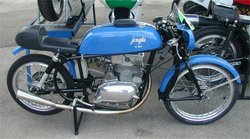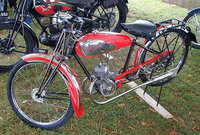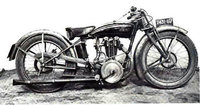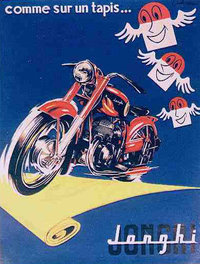Difference between revisions of "Jonghi"
m |
m |
||
| Line 63: | Line 63: | ||
* [[Jean Pierre Beltoise]], one of the most famous French F1 drivers of the'60s and'70s, began his sporting career in the saddle "Jonghi bialbero ACT 125 (ex Michel), which won the Trophy [[Montlhery]] in 1959. | * [[Jean Pierre Beltoise]], one of the most famous French F1 drivers of the'60s and'70s, began his sporting career in the saddle "Jonghi bialbero ACT 125 (ex Michel), which won the Trophy [[Montlhery]] in 1959. | ||
Italian | Italian | ||
| + | |||
| + | |||
| + | == History of the series production == | ||
| + | [[Image: NagasRayJonghi1930.jpg | 200px | right | thumb | The Nagase & Rai - Jonghi 350 cc valve head in 1930]] | ||
| + | * Culbuteurs'''350'' '<br/> Motorcycle 4T single cylinder engine with a valve in the head (the continuation of the pattern "Nagase & Ray Sport 350"). Approximately 20 specimens produced in 1930. | ||
| + | * TJ4 Culbuteurs'''350'' '<br/> Motorcycle 4T single cylinder engine with a valve in the head. Power of 20 hp at 5800 rpm and maximum speed of 135 km / h. Some 300 copies produced from 1931 to 1939. | ||
| + | * TJ4 laterales'''350'' '<br/> Motorcycle 4T single cylinder engine with a valve in the head. Power of 14 Cv to 3800 rpm and maximum speed of 115 km / h. Approximately 500 products from 1931 to 1939. | ||
| + | *'' 'T 100''' <br/> Motoleggera with single-cylinder engine 2T (carburetor left side) produced from 1938 to 1945 | ||
| + | [[Image: Jonghi poster.jpg | thumb | right | 200px | Advertising H54T Jonghi 250]] | ||
| + | *'' 'T 125''' <br/> Motoleggera with single-cylinder engine 2T (carburetor left side) produced from 1946 to 1949. 4.5 Cv power to 5400 rpm and maximum speed of 70 km / h. | ||
| + | *'' 'E50 125''' <br/> Motoleggera with single-cylinder engine 2T (carburetor rear) produced about 12,000 copies in 1949 to 1956. 6 Cv power at 6,800 rpm and maximum speed of 75 km / h. | ||
| + | * ACT'''125'' '<br/> Motoleggera with single-cylinder engine 4T (distribution with overhead camshaft) produced in about 500 individuals from 1949 to 1955. 8 Cv power at 7,000 rpm and maximum speed of 100 km / h. | ||
| + | * H'''250'' '<br/> 2T Motorcycle with single-cylinder engine. 9 Cv power to 4,500 rpm and maximum speed of 100 km / h. About 1,200 copies produced from 1951 to 1953. | ||
| + | * H54T'''250'' '<br/> 2T Motorcycle with single-cylinder engine and telescopic fork. 9 Cv power to 4,500 rpm and maximum speed of 100 km / h. Produced from 1954 to 1957. | ||
| + | *'' 'Polo 125''' <br/> Motorcycle Scooter-2T single cylinder engine with horizontal produced about 1,000 copies from 1953 to 1957. 6 Cv power at 6,800 rpm and maximum speed of 80 km / h. | ||
| + | |||
| + | Technical Data == == | ||
| + | |||
| + | (| Border = 1 style = "border-style: solid; border-width: 1px; border-color: # 808080; background-color: # FFFFFF" cellspacing = "2" cellpadding = "2" | ||
| + | |-align = "center" bgcolor = "# cccccc" | ||
| + | | Colspan = 2 | <big>'' 'Technical Jonghi 125 ACT''' </ big> | ||
| + | |----- | ||
| + | | [[Engine]] | | Monocilindrico vertical Otto cycle (4T) air-cooled | ||
| + | |----- | ||
| + | | [[Capacity]] | | 124 cc ([[Bore]] x [[stroke (mechanical) | race]] 54 x 54 mm) | ||
| + | |----- | ||
| + | | [[Distribution (mechanical) | Distribution]] | | overhead camshaft | ||
| + | |----- | ||
| + | | [[Power (physics) | power]] max | | 8 [[Cavallo steam | CV]] at 7000 rpm | ||
| + | |----- | ||
| + | | [[Clutch (mechanical) | Clutch]] | | Hard multiple oil | ||
| + | |----- | ||
| + | | [[Currency (mechanical) | Change]] | | 4 relations | ||
| + | |----- | ||
| + | | Final | | Chain | ||
| + | |----- | ||
| + | | Goodwill | | A pedal | ||
| + | |----- | ||
| + | | | Frame | | Tubular double cradle open | ||
| + | |----- | ||
| + | | [[Suspension (mechanical) | Suspension]] ant. | | Fork with adjustable shock Central | ||
| + | |----- | ||
| + | | Suspensions post. | | Forcellone oscillating with [[shock | shock]] | ||
| + | |----- | ||
| + | | [[Brake | Brakes]] | | ant. and post. [[drum brake | drum]] by 130 mm; | ||
| + | |----- | ||
| + | | [[Tires | Tires]] | | ant. 25 x 2.75; post. 25 x 3.00 | ||
| + | |----- | ||
| + | | Wheel | | 1280 [[mm | mm]] | ||
| + | |----- | ||
| + | | Curb weight | | 100 [[kilogram | kg]] | ||
| + | |----- | ||
| + | | Tank | | 10 liters | ||
| + | |----- | ||
| + | | [[Acceleration]] | | 13.7 seconds about 400 meters from detention | ||
| + | |----- | ||
| + | | [[Speed]] Maximum | | 100 km / h | ||
| + | |----- | ||
| + | |) | ||
| + | |||
| + | |||
| + | |||
| + | |||
| + | More info coming... | ||
| + | |||
| + | |||
| + | Send what you got to: | ||
| + | *[mailto:Info@WheelsofItaly.com '''info@wheelsofitaly.com'''] | ||
| + | |||
| + | |||
| + | |||
| + | {{Motorcycle Information and Photos by Marque}} | ||
| + | {{Car Information and Photos by Marque}} | ||
Revision as of 19:38, 28 January 2009
The 'Jonghi' is a 'company Italian-French produced motorcycles from 1930 to 1957.
Born in Milan from the ashes of "Nagase & Ray", was moved to France taking the brand "Constructions Mécaniques Jonghi" and, after, "Prester-Jonghi and Motos Jonghi".
History
Everything starts from the crisis in which, in 1929, the collapse was "Nagase & Ray". The technical director, engineer Joseph Remondini, try to save the company looking for new backers who can anticipate the funds needed to produce new models designed. Collects the appeal, the industrial Argentine Tito Jonghi that impose their surname as a new name and then decide on the transfer of France.
In 1932, a Choisy-le-Roi (an industrial suburb on the outskirts of Paris), began production of the French "Jonghi" machines from the very sportiveggianti, whose performance is plays everything. A 350-Jonghi TJ4 (Tito Jonghi 4T) valve in the head, derived from the model prededente "Nagase & Ray", appears before the Grand Prix of Nations Rome of 1932, led by Louis Jeannin. Under the gaze of astonished fans and hierarchs, the Jonghi triumphs in Class 350, the average of 134 km / h, with a three-minute advantage over second classified motorcycle.
In those years, it also produced a cheaper version TJ4 a 350-valve side, but despite the efforts and successes productive sports, sales will not be sufficient to cover the substantial start-up costs and the company arrives to declare bankruptcy in May 1933. The company is recognized by the brothers Eichel (already owners of "Prester") and restarted production under the brand "Prester-Jonghi".
The spread of motorcycles is hampered by higher than average price of competitors, but many owners of "Prester Jonghi-350 Culbuteurs" produced, will try competitions, claiming a successful and contributing significantly to the spread of a ' sports winning image.
In 1936 a Prester Jonghi-350 bialbero, specially designed by Remondini and driven by George Monneret, establish the world record for speed the time (170,840km/h) that is added to the previous record the year before they won in the category side.
But the glory is not enough to overcome the budget Eichel and the brothers decided to start production of an engine support for cycle, designed by Remondini, which result in a significant success outside the borders of France. In 1937 the production of a motor bike with 100 cc 2 stroke, type of loss. The welcome is warm, but to dispel the doubts about the robustness of the vehicle, because of small displacement in 1938 is carried out successfully with the crossing of the desert Saharan . The demonstration turns into an immediate commercial success.
It seems that Prester-Jonghi can finally surf in calm waters, but the World War II scombina cards yet. During the Nazi of France, the brothers are deported to Eichel camps, and like millions of others Jews, will no longer return home.
In 1944, the Prester-Jonghi SatAM is detected by, a company specialized in refrigeration and distribution of fuel, which ensures the continuity Remondini leaving the technical direction. The factory was relocated to larger stable to La Courneuve and the label is changed to "Motos Jonghi.
The production "Motos Jonghi" began in 1945 re the bike with an engine of 100 cc that the following year is increased to 125 cc. A model that will be produced in more than 12,000 copies.

Remondini can now devote himself to his true passion: the 4-stroke engines sports. The war is now a thing, l 'economics European flourishes and the time is ripe to propose a motion from tech. Salon Paris of 1948 is presented the "125 Jonghi ACT" (acronym forArbre en Tête à Cames, camshaft in the head) that surprised by its modernity. Moved by a propeller 4T under 125 cc developing a power 8 cv, it can reach 100km/h.
In 1951 is presented the "250 H", a utility with 2T engine power and low in relation to displacement. Followed in 1953, the model "Pole 125", a motor-scooter to 2T clearly "inspired" to "Moto Guzzi Galletto". It will be the last proposal Jonghi.
In advance of all 'Italy, the fifties will mark the decline of the French motorcycle market. The marketing of a car as the economic "Citroën 2CV", he completely changed the balance of the market: just think of that sale in 1948 with a production rate of 100 cars a month, already in [[1950] ], the 2CV had reached 400 units produced daily. From year to year sales of automobile utility have increased exponentially in proportion to the popular desire to move on four wheels rather than two.
It was a swift and devastating crisis that manufacturers expected French and their European competitors did not understand. In few years, dozens of case motorcycling overnight were forced to reduce production or close down. Of the latter, in 1957 the Jonghi. Joseph Remondini died in 1959 and his son Henry is "enrolled" by Matra and inserted nell'equipe giving life to the famous V12 by Formula 1.
Sporting activity
Particularly intense and felt it was the sport of Jonghi, which Remondini allocated much of its inventiveness, creating engines specially designed for competition. At that time, as still, the races were an important promotional vehicle for Remondini, an important system for testing. With both private and official riders, the Jonghi has participated in numerous individual competitions, championships and record attempts. Pilots as Jeannin, Monneret Dagan, Perrin and Michel, in the decade preceding the Second World War, have captured a remarkable series of victories, by providing a palmares impressive for a company of such modest size. Many of the successes in the conquest of Jonghi speed record, a type of "competitive distance" between the manufacturers, at the very time followed by the European public. Many of these record were won by Henry, son of Joseph Remondini, mechanic, and pilot testing of significant quality.
World Record Speed
- On km class launched 250 cc to 160km/h in the 1934
- At km 350cc class launched a 170,840km/h in the 1936 Pilot George Monneret
- On 50 km 125cc class at 122,724km/h in the 1948 Pilota Arrigo Remondini
- On 50 miles 125 cc class at 123,146 km/h in 1948 Pilota Arrigo Remondini
- On 5 and 10km 125cc class at 124,280km/h in 1948 Pilota Arrigo Remondini
- On 5 and 10miles to 125cc class 120,984km/h in 1948 Pilota Arrigo Remondini
- Of the 100km to 125cc class 122,897km/h in 1948 Pilota Arrigo Remondini
Trivia
- In September 1943, with clear view to the future post-war period, the torinese SIATA (Società Italiana Applicazioni Tecniche Auto-Aviator) decided to design an engine to be provided to manufacturers of bicycles. The top management chose to make a propeller "type Remondini" at the time considered the best example of an auxiliary motor. In a clandestine meeting (the war was still in progress) Remondini SIATA delivered to the drawings of his engine on which to work. Made with very different technical and put on sale on July 26 1945 with the name "Cub", was the first realization of the postwar European motoring. The engine was so successful that the SIATA failed to meet the demands and had to turn to a company Bologna supply electromechanical (at that time managed by IRI) that in this way began to produce motorcycles: the Ducati.
- On October 15 1948 is the day fixed for the wedding of Henry Remondini. Contrary to custom, the bride has to wait a long time her future husband, who does not wish to lose the ideal conditions for groped to beat the speed record of 125 class on the distance of 100 km. The marriage will be celebrated in the late afternoon, won a world record, as a tribute to the bride.
- Jean Pierre Beltoise, one of the most famous French F1 drivers of the'60s and'70s, began his sporting career in the saddle "Jonghi bialbero ACT 125 (ex Michel), which won the Trophy Montlhery in 1959.
Italian
History of the series production
- Culbuteurs'350 '
Motorcycle 4T single cylinder engine with a valve in the head (the continuation of the pattern "Nagase & Ray Sport 350"). Approximately 20 specimens produced in 1930. - TJ4 Culbuteurs'350 '
Motorcycle 4T single cylinder engine with a valve in the head. Power of 20 hp at 5800 rpm and maximum speed of 135 km / h. Some 300 copies produced from 1931 to 1939. - TJ4 laterales'350 '
Motorcycle 4T single cylinder engine with a valve in the head. Power of 14 Cv to 3800 rpm and maximum speed of 115 km / h. Approximately 500 products from 1931 to 1939. - 'T 100'
Motoleggera with single-cylinder engine 2T (carburetor left side) produced from 1938 to 1945
- 'T 125'
Motoleggera with single-cylinder engine 2T (carburetor left side) produced from 1946 to 1949. 4.5 Cv power to 5400 rpm and maximum speed of 70 km / h. - 'E50 125'
Motoleggera with single-cylinder engine 2T (carburetor rear) produced about 12,000 copies in 1949 to 1956. 6 Cv power at 6,800 rpm and maximum speed of 75 km / h. - ACT'125 '
Motoleggera with single-cylinder engine 4T (distribution with overhead camshaft) produced in about 500 individuals from 1949 to 1955. 8 Cv power at 7,000 rpm and maximum speed of 100 km / h. - H'250 '
2T Motorcycle with single-cylinder engine. 9 Cv power to 4,500 rpm and maximum speed of 100 km / h. About 1,200 copies produced from 1951 to 1953. - H54T'250 '
2T Motorcycle with single-cylinder engine and telescopic fork. 9 Cv power to 4,500 rpm and maximum speed of 100 km / h. Produced from 1954 to 1957. - 'Polo 125'
Motorcycle Scooter-2T single cylinder engine with horizontal produced about 1,000 copies from 1953 to 1957. 6 Cv power at 6,800 rpm and maximum speed of 80 km / h.
Technical Data == ==
(| Border = 1 style = "border-style: solid; border-width: 1px; border-color: # 808080; background-color: # FFFFFF" cellspacing = "2" cellpadding = "2" |-align = "center" bgcolor = "# cccccc" | Colspan = 2 | 'Technical Jonghi 125 ACT' </ big> |----- | Engine | | Monocilindrico vertical Otto cycle (4T) air-cooled |----- | Capacity | | 124 cc (Bore x race 54 x 54 mm) |----- | Distribution | | overhead camshaft |----- | power max | | 8 CV at 7000 rpm |----- | Clutch | | Hard multiple oil |----- | Change | | 4 relations |----- | Final | | Chain |----- | Goodwill | | A pedal |----- | | Frame | | Tubular double cradle open |----- | Suspension ant. | | Fork with adjustable shock Central |----- | Suspensions post. | | Forcellone oscillating with shock |----- | Brakes | | ant. and post. drum by 130 mm; |----- | Tires | | ant. 25 x 2.75; post. 25 x 3.00 |----- | Wheel | | 1280 mm |----- | Curb weight | | 100 kg |----- | Tank | | 10 liters |----- | Acceleration | | 13.7 seconds about 400 meters from detention |----- | Speed Maximum | | 100 km / h |----- |)
More info coming...
Send what you got to:




